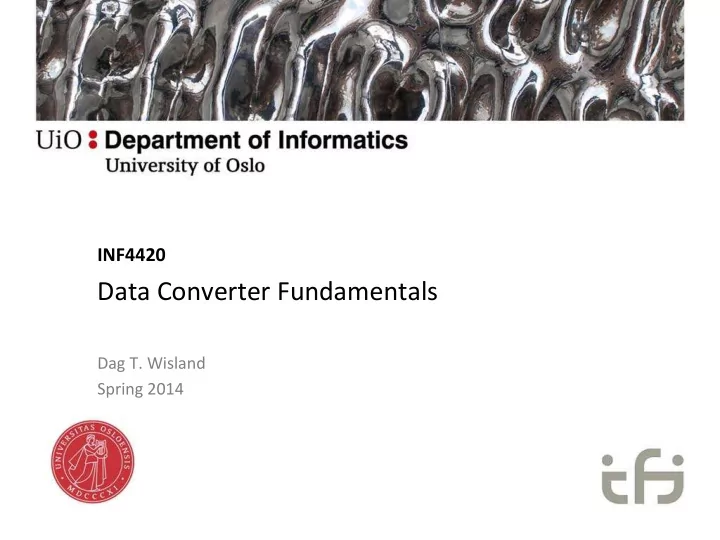

INF4420 Data Converter Fundamentals Dag T. Wisland Spring 2014
Outline • Quantization • Static performance • Dynamic performance Spring 2014 Data Converter Fundamentals 2
Introduction Digital processor Signal processing is usually more efficient, robust, and convenient in the digital domain (algorithms in digital circuits and software). Need to convert to and from analog to interface with the world Spring 2014 Data Converter Fundamentals 3
Introduction Anti-alias filter Reconstruction filter Digital processing When interacting with the real world, the inputs and outputs are analog: Audio, video, motion, light level, … Spring 2014 Data Converter Fundamentals 4
Introduction Data conversion accuracy limits system performance In-depth understanding of data converter performance is important in many applications How do we quantify data converter performance? Spring 2014 Data Converter Fundamentals 5
Introduction Important to pay close attention to mixed signal issues when designing, such as layout. Data converters combine sensitive high accuracy circuits for generating reference levels (bandgaps) with digital switching (current spikes). For high resolution converters, the external environment (e.g. PCB) is very important. Spring 2014 Data Converter Fundamentals 6
Digital to analog conversion Spring 2014 Data Converter Fundamentals 7
Digital to analog conversion Spring 2014 Data Converter Fundamentals 8
Digital codes Several possibilities for representing the digital values • Unipolar • Sign magnitude • 1’s complement • 2’s complement • Offset binary Spring 2014 Data Converter Fundamentals 9
Analog to digital conversion Ideally, the analog input has infinite precision • Limited by noise • Distortion sets a practical limit The output has a finite number of information carrying units (bits) The ADC quantizes the input voltage to a finite number of bits Spring 2014 Data Converter Fundamentals 10
Quantization Spring 2014 Data Converter Fundamentals 11
Quantization Spring 2014 Data Converter Fundamentals 12
Quantization Spring 2014 Data Converter Fundamentals 13
Quantization noise Model the quantization error as noise added to the original signal. Enables linear analysis. Spring 2014 Data Converter Fundamentals 14
Quantization noise Quantization noise assumptions: • All quantization levels have equal probability • Large number of quantization levels, M • Uniform quantization steps, constant Δ • Quantization error uncorrelated with input Quantization noise is white Spring 2014 Data Converter Fundamentals 15
Quantization noise Spring 2014 Data Converter Fundamentals 16
Quantization noise Assuming sine wave input SNR due to quantization noise Spring 2014 Data Converter Fundamentals 17
Sampling jitter Uncertainty in the timing of the sampling clock due to circuit electrical noise (white noise and flicker noise). Reference edge Spring 2014 Data Converter Fundamentals 18
Sampling jitter Sampling time uncertainty translates to an error in the input voltage. Need a low noise sampling clock to get high accuracy. Spring 2014 Data Converter Fundamentals 19
Sampling jitter Spring 2014 Data Converter Fundamentals 20
Performance specifications How precise is the data conversion? Different metrics to quantify the performance. Achieving high resolution is costly (in terms of power and complexity). Important to understand the performance requirements of the application. Spring 2014 Data Converter Fundamentals 21
Static specifications • Gain • Offset • INL • DNL • Missing codes • Monotonicity • … Spring 2014 Data Converter Fundamentals 22
Gain and offset Easily corrected, does not limit accuracy. Corrected before calculating INL and DNL, etc. Spring 2014 Data Converter Fundamentals 23
Integral non-linearity error INL measures deviation from a straight line (best fit straight line or based on end points), after correcting for offset and gain error. Result usually given in LSBs. Static, meaning measured from DC inputs. Spring 2014 Data Converter Fundamentals 24
Differential non-linearity error DNL is a measure of the step size error. Ideally the distance between two codes are exactly 1 LSB (after correcting for gain and offset). Like INL measured at DC. Both INL and DNL are common measures of data converter accuracy. Spring 2014 Data Converter Fundamentals 25
Monotonicity and missing codes Monotonicity is applicable to DACs. Increasing the input code should always increase the output voltage. Severe non-linearity will cause the output to decrease when the input increases. Missing codes in ADCs when an output code does not occur for any input voltage. Settling time and finite speed also important to consider. Spring 2014 Data Converter Fundamentals 26
Dynamic specifications Measure the performance when the input is a sine wave. Look at the converter output spectrum. • SNR • SINAD (SNDR) • SFDR • THD • DR Spring 2014 Data Converter Fundamentals 27
SFDR Spring 2014 Data Converter Fundamentals 28
SNR Spring 2014 Data Converter Fundamentals 29
THD Spring 2014 Data Converter Fundamentals 30
SINAD Spring 2014 Data Converter Fundamentals 31
Dynamic specifications Other dynamic specifications • Intermodulation distortion • Glitching • … Spring 2014 Data Converter Fundamentals 32
Effective number of bits Spring 2014 Data Converter Fundamentals 33
Figure of merit Spring 2014 Data Converter Fundamentals 34
Effective bandwidth Dynamic performance metrics requires us to test with a sine wave input. Which frequency should we use? The effective bandwidth tells us the frequency where the SINAD is 3 dB lower than the best case value. Spring 2014 Data Converter Fundamentals 35
Resources Converter Passion (blog covering many aspects of data converters) Kester , The Data Conversion Handbook, Analog Devices, 2004. Spring 2014 Data Converter Fundamentals 36
Recommend
More recommend